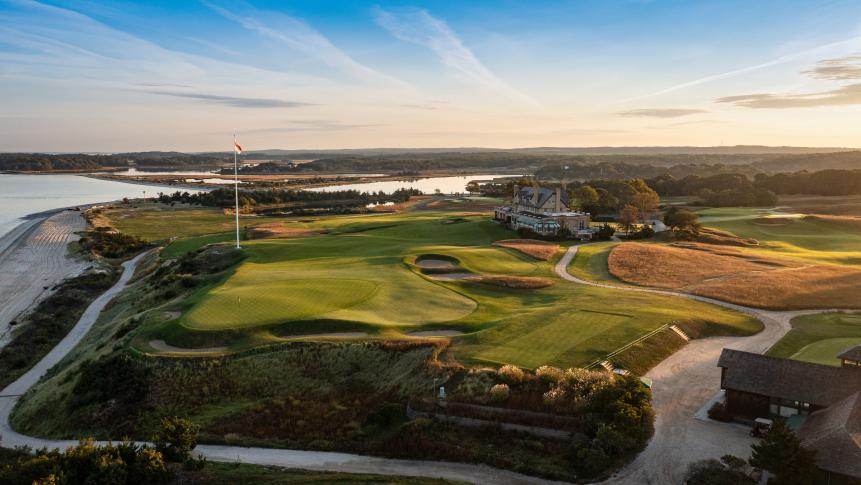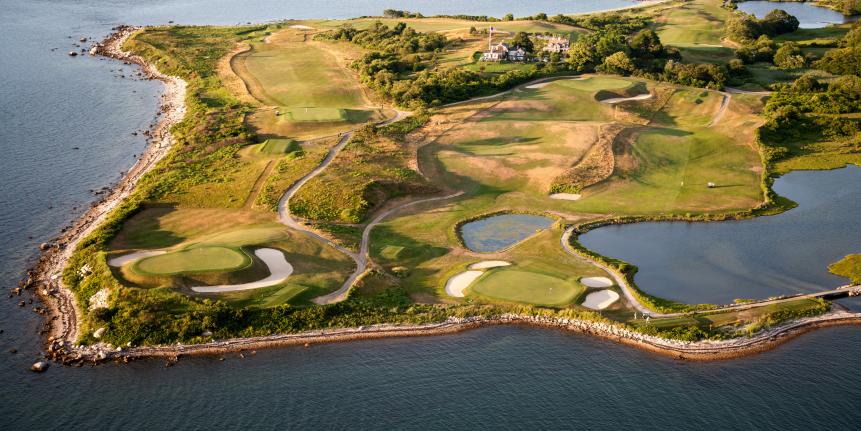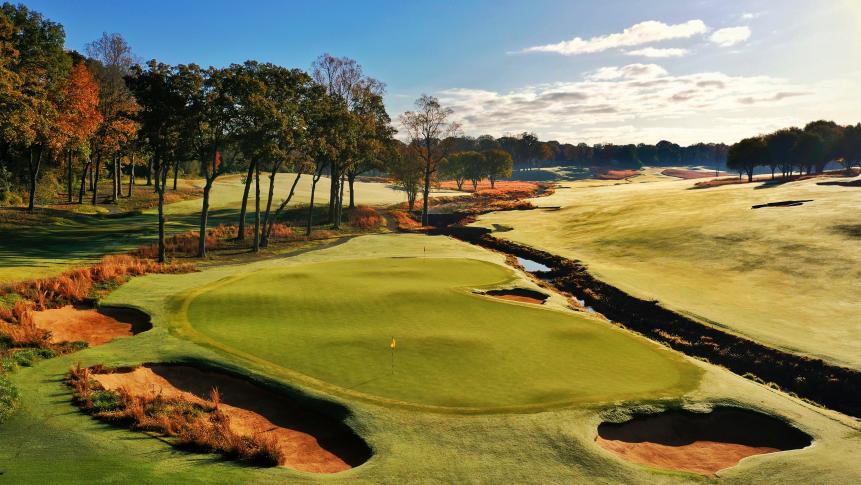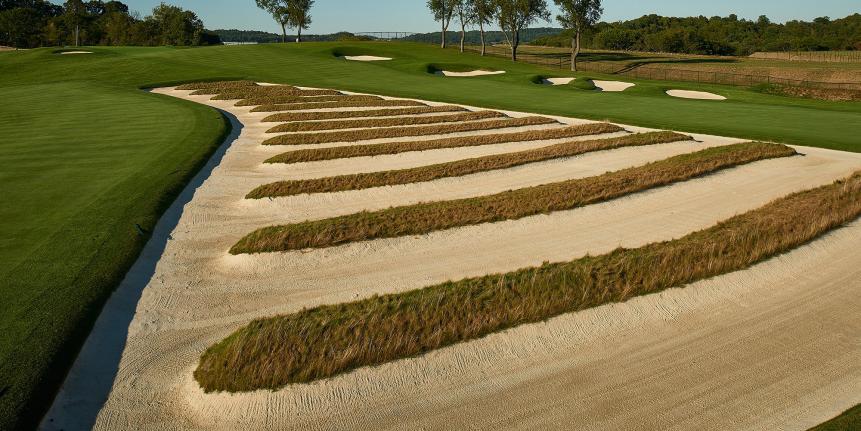The debate over which state in the United States has the best golf is tricky, not only because there are so many worthy contenders, but also because it’s tough to agree upon one definition of what the “best golf" is. In our latest ranking of America’s 100 Greatest and Second 100 Greatest Golf Courses, 39 states are represented—providing a number of opportunities to study the results and deliver an answer to the above question.
In terms of which state boasts the most courses in the upper echelon of our rankings—that is, courses inside our top 10 and in our top 100—New York stands alone. The Empire State has three gems inside the top 10 (No. 4, Shinnecock Hills, No. 7 National Golf Links of America and No. 9 Fishers Island) and 15 inside our top 100.
You’ll notice all three of New York’s best courses are private clubs (as are 14 of the state’s 15 in the top 200), so what about the states with the best public golf? That belongs to Oregon and Wisconsin, whose top resorts are among the nation’s best, giving them five public courses each inside our top 200. In terms of the sheer number of courses open for public play, you have to throw Florida and South Carolina in the mix as well.

Stephen Szurlej
For our purposes, though, we’re determining the states with the best golf by tallying all the courses inside our top 200. California, with 21 courses, takes the top spot, edging out New York. Though the Golden State has 13 courses inside the top 100, trailing its East Coast rival, the impressive depth in our Second 100 Greatest puts California over the edge. Florida, with 13 courses inside the top 200, rounds out the Big Three.
To help you argue your case during your next grillroom debate, here are the top 10 states with the most courses ranked inside our 2023-2024 America’s 100 Greatest and Second 100 Greatest lists.
1. California (21)

From Golf Digest Architecture Editor emeritus Ron Whitten:
Cypress Point, the sublime Monterey Peninsula work of sandbox sculpture, whittled Cypress and chiseled coastline, has become Exhibit A in the argument that classic architecture has been rendered ineffectual by modern technology.
I'm not buying that argument. Those who think teeny old Cypress Point is defenseless miss the point of Alister MacKenzie’s marvelous design.
MacKenzie relished the idea that Cypress Point would offer all sorts of ways to play every hole. That philosophy still thrives, particularly in the past decade, after the faithful restoration of MacKenzie’s original bunkers by veteran course superintendent Jeff Markow.
Explore our complete review here—including bonus photography and ratings from our expert panelists.


18. Riviera C.C.
33. San Francisco G.C.
35. The Olympic Club (Lake)
62. Monterey Peninsula C.C. (Shore)
67. Spyglass Hill G. Cse.
71. California G.C.
76. The Valley Club of Montecito
79. Monterey Peninsula C.C. (Dunes)
91. The Quarry at La Quinta
96. Pasatiempo G.C.
103. Saint Lucia Preserve
113. The Madison Club
122. Stone Eagle G.C.
134. Martis Camp
135. Bel-Air C.C.
137. Mayacama G.C.
187. Sherwood C.C.
189. Tradition G.C.
2. New York (17)



11. Winged Foot G.C. (West)
15. Friar’s Head G.C.
22. Oak Hill C.C. (East)
39. Bethpage State Park (Black)
43. Sebonack G.C.
52. Maidstone Club
59. Sleepy Hollow C.C.
61. Winged Foot G.C. (East)
64. Garden City G.C.
81. Quaker Ridge G.C.
88. Hudson National G.C.
97. Piping Rock Club
129. The Creek
175. Atlantic G.C.
3. Florida (13)



109. Jupiter Hills Club (Hills)
127. Streamsong Resort (Red)
133. The Concession G.C.
142. The Dye Course at White Oak
151. Streamsong Resort (Blue)
178. Streamsong Resort (Black)
179. MacArthur G.C.
180. The Bear’s Club
181. Medalist G.C.
193. Mountain Lake C.C.
T-4. New Jersey (10)



80. Baltusrol G.C. (Upper)
82. Plainfield C.C.
152. Ridgewood C.C. (East/West)
165. Galloway National G.C.
170. Hollywood G.C.
177. Bayonne G.C.
194. Liberty National G.C.
T-4. North Carolina (10)



77. Diamond Creek
111. Mountaintop Golf & Lake Club
114. Eagle Point Golf Club
119. Quail Hollow Club
154. Grandfather Golf & C.C.
171. Pinehurst No. 4
195. Charlotte C.C.
6. South Carolina (9)



153. Sage Valley G.C.
159. Secession G.C.
160. Harbour Town Golf Links
166. Kiawah Island Club (Cassique)
188. Long Cove Club
200. Kiawah Island Club (River)
T-7. Illinois (8)



85. Canyata G.C.
93. Medinah C.C. (No. 3)
99. Olympia Fields C.C. (North)
108. Rich Harvest Farms
164. Old Elm Club
T-7. Ohio (8)



58. Inverness Club
60. Scioto C.C.
107. Double Eagle Club
146. Moraine C.C.
192. Canterbury G.C.
T-7. Massachusetts (8)



78. Essex County Club
89. The Kittansett Club
90. Boston G.C.
102. Eastward Ho!
196. Sankaty Head G.C.
T-10. Georgia (6)



From Golf Digest Architecture Editor emeritus Ron Whitten:
I’ve been told Gil Hanse had first examined the site of Ohoopee Match Club as far back as 2006 considered it ideal for golf: gently rolling terrain with no severe elevation changes, and beautiful sandy soil deposited by the nearby Ohoopee River, perfect for drainage and firm, fast conditions.
The ground around tiny Cobbtown, Ga., is also perfect for growing onions—it’s just northeast of Vidalia, world-famous for the Vidalia onion. Indeed, Ohoopee’s logo is a freshly picked onion, although if you look closely, its roots are three writhing snakes.
Any symbolism pertaining to match play is uncertain; perhaps it simply suggests the sort of putts one will face. What’s the composition of a course meant for match play? One might think it would contain lots of penal hazards, because a triple bogey on any particular hole would not be fatal in match play.
Perhaps the targets would be smaller than normal, to level the playing field between big hitters and short-but-accurate golfers. That’s not the composition of the 7,325-yard championship course at Ohoopee. Hanse did produce dramatic visuals in this sandy locale that hark back to portions of Pinehurst and Pine Valley, from long expanses of sandy rough dotted with native plants to deep, foreboding pits of sand, but they’re mostly on the far perimeter of holes.
Explore our complete review here—including bonus photography and ratings from our expert panelists.
T-10. Pennsylvania (6)



T-10. Wisconsin (6)



116. Sand Valley
117. Blackwolf Run (River)
158. Mammoth Dunes
• • •
Explore Golf Digest's recently relaunched Places to Play community, where you can add star ratings and reviews for all the courses you play. We've collected tens of thousands of reviews from our course-ranking panelists to deliver a premium experience, which includes experts' opinions, bonus course photography and videos, plus much more. Check it out here!







